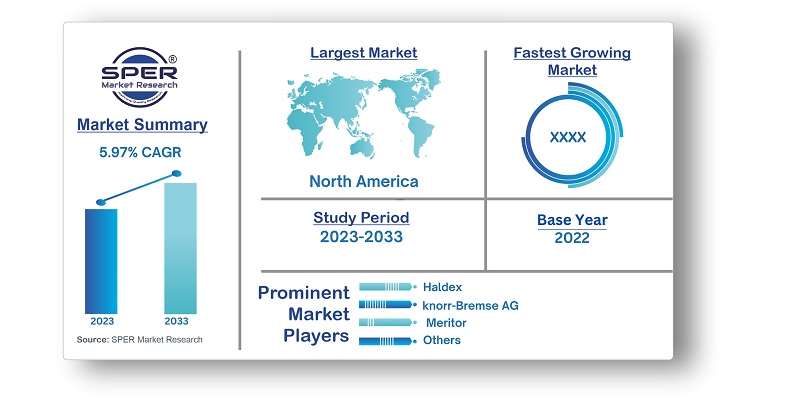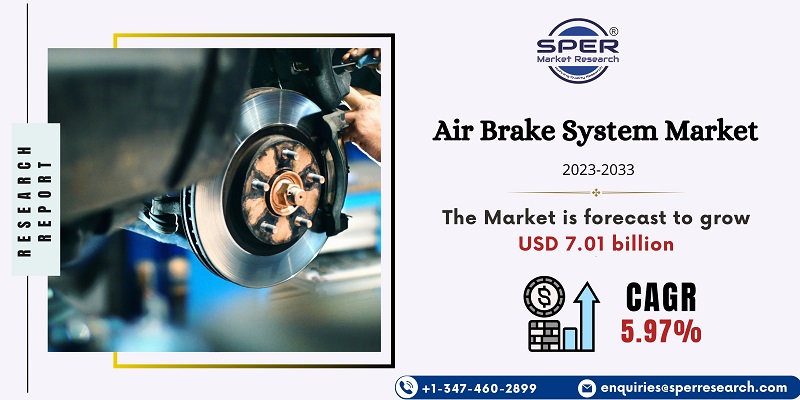
Air Brake System Market Growth, Size, Trends, Revenue, Share, Competition and Future Outlook
Air Brake System Market Size- By Type, By Component, By Technology, By Vehicle Type, By Application- Regional Outlook, Competitive Strategies and Segment Forecast to 2033
| Published: Dec-2023 | Report ID: AMIN23195 | Pages: 1 - 230 | Formats*: |
| Category : Automotive & Transportation | |||
- In September 2022: Knorr-Bremse AG unveiled the upgraded SYNACT Braking system with Active Calliper Release (ACR) in September 2022. The most recent pneumatic version is designed with lighter brake callipers and backing plates and increased braking torque in comparison to the previous generation. A spring-loaded mechanism is used by the optional Active Calliper Release (ACR) to release the pads from the disc and realign the calliper. This is intended to lessen brake pad wear and cut fuel consumption by up to 1%.
- January 2021: Dell and Navitas Semiconductor collaborated to create cutting-edge GaN-based charging technology. The two companies have teamed up to develop new uses for gallium nitride (GaN).


| Report Metric | Details |
| Market size available for years | 2019-2033 |
| Base year considered | 2022 |
| Forecast period | 2023-2033 |
| Segments covered | By Type, By Component, By Technology, By Vehicle Type, By Application. |
| Regions covered | North America, Asia-Pacific, Latin America, Middle East & Africa and Europe |
| Companies Covered | Haldex, knorr-Bremse AG, Meritor, Inc., Nabtesco Automotive Corporation, SORL Auto Parts, Inc., Tenneco Inc., TSE Brakes Inc., WABCO, Wabtec Corporation, ZF Friedrichshafen AG, Others |
- Aftermarket Suppliers and Distributors
- Automobile Manufacturers
- Automotive Associations and Trade Groups
- Automotive Component Suppliers
- Brake System Maintenance and Repair Services
- Commercial Drivers and Operators
- Commercial Vehicle Owners and Operators
- Fleet Maintenance Departments
- Fleet Managers
- Others
| By Type: |
|
| By Component: |
|
| By Technology: |
|
| By Vehicle Type: |
|
| By Application: |
|
- Global Air Brake System Market Size (FY’2023-FY’2033)
- Overview of Global Air Brake System Market
- Segmentation of Global Air Brake System Market By Type (Air Disc Brake, Air Drum Brake)
- Segmentation of Global Air Brake System Market By Component (Air Dryer, Brake Chamber, Foot Valve, Governor, Slack Adjuster, Tank, Others)
- Segmentation of Global Air Brake System Market By Technology (Anti-Lock Braking System, Electronic Brake Force Distribution, Electronic Stability Program or Electronic Stability Control, Traction Control System)
- Segmentation of Global Air Brake System Market By Vehicle Type (Bus, Heavy-Duty Truck, Rigid Body Truck, Rolling Stock, Semi-Trailer)
- Segmentation of Global Air Brake System Market By Application (Electronically Controlled Pneumatic, Locomotive Electro-Pneumatic, Off-Road Vehicle, On-Road, Rolling Stock, Others)
- Statistical Snap of Global Air Brake System Market
- Expansion Analysis of Global Air Brake System Market
- Problems and Obstacles in Global Air Brake System Market
- Competitive Landscape in the Global Air Brake System Market
- Impact of COVID-19 and Demonetization on Global Air Brake System Market
- Details on Current Investment in Global Air Brake System Market
- Competitive Analysis of Global Air Brake System Market
- Prominent Players in the Global Air Brake System Market
- SWOT Analysis of Global Air Brake System Market
- Global Air Brake System Market Future Outlook and Projections (FY’2023-FY’2033)
- Recommendations from Analyst
1.1. Scope of the report1.2. Market segment analysis
2.1. Research data source
2.1.1. Secondary Data2.1.2. Primary Data2.1.3. SPER’s internal database2.1.4. Premium insight from KOL’s
2.2. Market size estimation
2.2.1. Top-down and Bottom-up approach
2.3. Data triangulation
4.1. Driver, Restraint, Opportunity and Challenges analysis
4.1.1. Drivers4.1.2. Restraints4.1.3. Opportunities4.1.4. Challenges
4.2. COVID-19 Impacts of the Global Air Brake System Market
5.1. SWOT Analysis
5.1.1. Strengths5.1.2. Weaknesses5.1.3. Opportunities5.1.4. Threats
5.2. PESTEL Analysis
5.2.1. Political Landscape5.2.2. Economic Landscape5.2.3. Social Landscape5.2.4. Technological Landscape5.2.5. Environmental Landscape5.2.6. Legal Landscape
5.3. PORTER’s Five Forces
5.3.1. Bargaining power of suppliers5.3.2. Bargaining power of buyers5.3.3. Threat of Substitute5.3.4. Threat of new entrant5.3.5. Competitive rivalry
5.4. Heat Map Analysis
6.1. Global Air Brake System Market Manufacturing Base Distribution, Sales Area, Product Type6.2. Mergers & Acquisitions, Partnerships, Product Launch, and Collaboration in Global Air Brake System Market
7.1. Global Air Brake System Market Value Share and Forecast, By Type, 2023-20337.2. Air Disc Brake7.3. Air Drum Brake
8.1. Global Air Brake System Market Value Share and Forecast, By Component, 2023-20338.2. Air Dryer8.3. Brake Chamber8.4. Foot Valve8.5. Governor8.6. Slack Adjuster8.7. Tank
8.8. Others
9.1. Global Air Brake System Market Value Share and Forecast, By Technology, 2023-20339.2. Anti-Lock Braking System (ABS)9.3. Electronic Brake Force Distribution (EBD)9.4. Electronic Stability Program Or Electronic Stability Control (ESC)9.5. Traction Control System (TCS)
10.1. Global Air Brake System Market Value Share and Forecast, By Vehicle Type, 2023-203310.2. Bus10.3. Heavy-Duty Truck10.4. Rigid Body Truck10.5. Rolling Stock10.6. Semi-Trailer
11.1. Global Air Brake System Market Value Share and Forecast, By Application, 2023-203311.2. Electronically Controlled Pneumatic (ECP)11.3. Locomotive Electro-Pneumatic(EP)11.4. Off-Road Vehicle11.5. On-Road11.6. Rolling Stock11.7. Others
12.1. Global Air Brake System Market Size and Market Share
13.1. Global Air Brake System Market Size and Market Share By Type (2019-2026)13.2. Global Air Brake System Market Size and Market Share By Type (2027-2033)
14.1. Global Air Brake System Market Size and Market Share By Component (2019-2026)14.2. Global Air Brake System Market Size and Market Share By Component (2027-2033)
15.1. Global Air Brake System Market Size and Market Share By Technology (2019-2026)15.2. Global Air Brake System Market Size and Market Share By Technology (2027-2033)
16.1. Global Air Brake System Market Size and Market Share By Vehicle Type (2019-2026)16.2. Global Air Brake System Market Size and Market Share By Vehicle Type (2027-2033)
17.1. Global Air Brake System Market Size and Market Share By Application (2019-2026)17.2. Global Air Brake System Market Size and Market Share By Application (2027-2033)
18.1. Global Air Brake System Market Size and Market Share By Region (2019-2026)18.2. Global Air Brake System Market Size and Market Share By Region (2027-2033)
18.3. Asia-Pacific
18.3.1. Australia18.3.2. China18.3.3. India18.3.4. Japan18.3.5. South Korea18.3.6. Rest of Asia-Pacific
18.4. Europe
18.4.1. France18.4.2. Germany18.4.3. Italy18.4.4. Spain18.4.5. United Kingdom18.4.6. Rest of Europe
18.5. Middle East and Africa
18.5.1. Kingdom of Saudi Arabia18.5.2. United Arab Emirates18.5.3. Rest of Middle East & Africa
18.6. North America
18.6.1. Canada18.6.2. Mexico18.6.3. United States
18.7. Latin America
18.7.1. Argentina18.7.2. Brazil18.7.3. Rest of Latin America
19.1. Haldex
19.1.1. Company details19.1.2. Financial outlook19.1.3. Product summary19.1.4. Recent developments
19.2. knorr-Bremse AG
19.2.1. Company details19.2.2. Financial outlook19.2.3. Product summary19.2.4. Recent developments
19.3. Meritor, Inc.
19.3.1. Company details19.3.2. Financial outlook19.3.3. Product summary19.3.4. Recent developments
19.4. Nabtesco Automotive Corporation
19.4.1. Company details19.4.2. Financial outlook19.4.3. Product summary19.4.4. Recent developments
19.5. Tenneco Inc.
19.5.1. Company details19.5.2. Financial outlook19.5.3. Product summary19.5.4. Recent developments
19.6. TSE Brakes Inc.
19.6.1. Company details19.6.2. Financial outlook19.6.3. Product summary19.6.4. Recent developments
19.7. WABCO
19.7.1. Company details19.7.2. Financial outlook19.7.3. Product summary19.7.4. Recent developments
19.8. Wabtec Corporation
19.8.1. Company details19.8.2. Financial outlook19.8.3. Product summary19.8.4. Recent developments
19.9. ZF Friedrichshafen AG
19.9.1. Company details19.9.2. Financial outlook19.9.3. Product summary19.9.4. Recent developments
19.10. Others
SPER Market Research’s methodology uses great emphasis on primary research to ensure that the market intelligence insights are up to date, reliable and accurate. Primary interviews are done with players involved in each phase of a supply chain to analyze the market forecasting. The secondary research method is used to help you fully understand how the future markets and the spending patterns look likes.
The report is based on in-depth qualitative and quantitative analysis of the Product Market. The quantitative analysis involves the application of various projection and sampling techniques. The qualitative analysis involves primary interviews, surveys, and vendor briefings. The data gathered as a result of these processes are validated through experts opinion. Our research methodology entails an ideal mixture of primary and secondary initiatives.



Frequently Asked Questions About This Report
PLACE AN ORDER
Year End Discount
Sample Report
Pre-Purchase Inquiry
NEED CUSTOMIZATION?
Request CustomizationCALL OR EMAIL US
100% Secure Payment






Related Reports
Our Global Clients
Our data-driven insights have influenced the strategy of 200+ reputed companies across the globe.




















